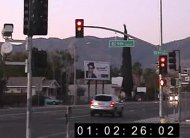11/24/2008
California: City Caught Trapping Drivers with Short YellowsVideo evidence shows a San Bernardino, California red light camera operating with a yellow time so short it violates state law.

A brand new red light camera on California's historic Route 66 is already generating thousands in revenue for San Bernardino, but the biggest lawbreaker in these cases may turn out to be the city itself. Since September 25, a photo ticketing device has watched over the intersection of Mount Vernon Avenue and 9th Street, trapping motorists caught by a yellow light that is so short it violates state law.
Truck driver Raymond Chacon discovered this last month while taking a training course to help him upgrade his commercial driver's license. Under the supervision of an instructor, he came to the intersection behind the wheel of a big-rig tractor trailer. He entered just a split-second after the light had turned red. After successfully completing the course and passing the Department of Motor Vehicles Class A license test "with flying colors," Chacon received a $400 red light camera ticket in the mail. Chacon immediately began investigating what might have happened at that location. He turned to the highwayrobbery.net website, which encouraged him to check whether the city used yellow signal timing that conformed with state guidelines.
Video from the intersection in question confirms that drivers are given only 3.0 seconds of yellow, even though the California Manual on Uniform Traffic Control Devices insists that 35 MPH intersections have a yellow of no less than 3.6 seconds. While this 0.6 second shortage appears insignificant, it can represent the difference between a ticket and no ticket for thousands of motorists. This is even more true for truck drivers like Chacon.
Most drivers faced with a quick-changing yellow can simply slam on their brakes to avoid the citation. For Chacon's 53-foot-long rig, however, the compressed-air braking system requires an extra 0.5 seconds to activate. Beyond the usual risk of causing a rear end collision in this situation, slamming the brakes with an unladen trailer risks jack-knifing the truck. With a properly timed signal, Chacon would have had enough time to clear the intersection.
Studies show that shorter yellow times can increase the number of citations generated. According to the Texas Transportation Institute, when the yellow light timing is one second shorter than the bare minimum recommended amount, violations increase by 110 percent (view study). Confidential documents uncovered in a San Diego court trial prove that the city and its private vendor, now Affiliated Computer Services (ACS), colluded to install red light cameras only at intersections with short yellow times (view documents), thereby maximizing profits.
San Bernardino may be aware of the importance of this signal timing. It is one of only a handful of cities across the country that deliberately conceals signal timing information -- including the "time into red" or "late time" -- on its citations. In 2002, a Baltimore, Maryland judge had used this information to find tickets issued at locations where the signal timing was illegally short. As a result of the judge's investigation, Baltimore was forced to refund thousands in citation revenue (Read court memo). Chacon insists that San Bernardino similarly provide refunds from those caught by the illegal signal timing on Mount Vernon Avenue.
"It is a cash cow for a financially strapped San Bernardino city," Chacon told TheNewspaper. "The fact that they knew the yellows were too short shows that public safety is not a sole concern for the red light cameras."
Earlier this month, the National Motorists Association Foundation announced that it had begun a nationwide search to track down intersections with short yellow times and force cities to comply with proper engineering practices. Visit the Short Yellow Lights Project website.
View signal timing video (Yellow begins at :23.03, ends at :26.03)


